Table of Contents
In today’s post I describe what causes a kyphotic posture and provide recommendations for people with kyphotic posture (also known as osteoporosis posture, in layman’s terms). The post and video also cover how poor posture habits can lead to vertebral compression fractures.
Individuals with osteoporosis, osteopenia or low bone density need to learn how to move carefully when they exercise and perform activities of daily living. This means that they need to practice and maintain a good postural alignment.
The video above:
- Explains some key concepts related to postural alignment and describes the difference between flexion and extension.
- Reviews the vertebral column and discusses compression fractures, and explains vertebral compression fractures.
In other articles on this site and in Exercise for Better Bones, I provide exercise recommendations to correct your posture.
Osteoporosis Posture
Individuals with osteoporosis can experience vertebral compression fractures — sometimes referred to as wedge fractures or simply “compressions”.
These fractures in the spine can cause a stooped, or forward-leaning posture. In the medical world, this is known as a kyphotic posture. Hyperkyphosis is an exaggerated forward thoracic curvature. Either of these is sometimes referred to as an “osteoporosis posture”.
It is important to note that there is a causal relationship between kyphosis or hyperkyphosis and vertebral compression fractures. (1) A 2009 study at University of California Los Angeles (UCLA) looked at whether “kyphosis of the thoracic spine is an independent risk factor for future osteoporotic fractures”. The researchers concluded “whereas hyperkyphosis may often result from vertebral fractures, our study findings suggest that hyperkyphotic posture itself may be an important risk factor for future fractures.”
A forward-leaning, stooped posture can lead to a number of changes in your body including difficulty breathing and poor balance.
Poor balance, in turn, can lead to falls. Falls are the most common cause of what is referred to as a macro-trauma or fracture of the spine, wrist(s), hips.
Best Postural Alignment
The diagnosis of osteopenia or osteoporosis has provided you with information you were not aware of.
If there is a silver lining in the diagnosis, it is that you now know that you can do more proactive things to prevent a fracture. You are in a better position to keep yourself safe during day-to-day activities.
Rather than be concerned about compressing your spine, you can be empowered to keep your self strong and your spine safe. Throughout the day, in all your daily activities and while exercising you can reinforce good alignment.
Ask those you love to kindly point out when they see you slouch. This will allow you, as you strengthen your spine, to gradually make changes to how you move.
Vertebral Body
The vertebral column is also known as our spinal column. Our head sits at the very top and the pelvis sits on either side of the sacrum. To the right is an illustration that identifies the major parts of the vertebral body:
The small protruding bones you feel at the back of your neck and down to the sacrum are the individual spinous processes of each vertebra.
The stomach-facing side of the vertebra is referred to as the body of the vertebra. It is shaped like a marshmallow. This is the portion of the vertebra that is most vulnerable to compression fractures. We will concentrate our discussion on this part of the spine.
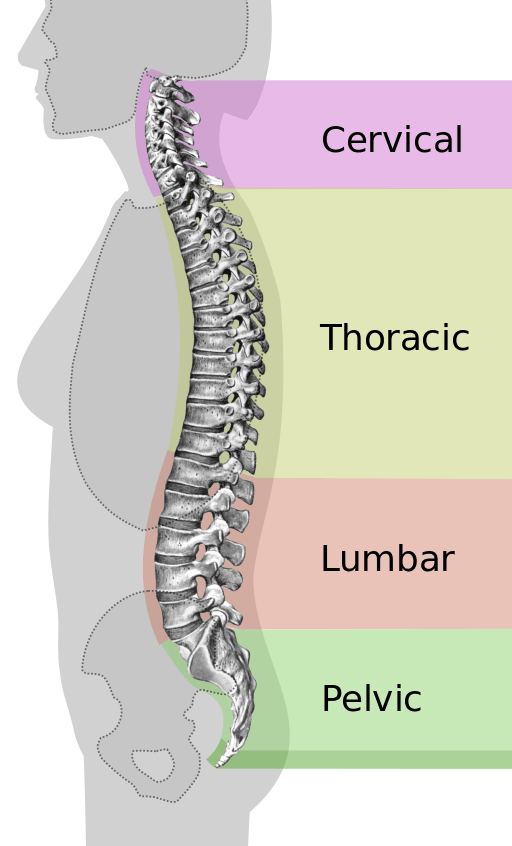
The image to the right is a cross section of one of the vertebral bodies in the spine. Note the knobby section (facing out and away from your body) and the smooth side (facing towards the inside your body).
There are different kinds of bone within the vertebral body. The outside of the vertebral body is a hard bone called cortical bone.
Inside the vertebral body is trabecular bone — also referred to as cancellous or spongy bone. Trabecular bone is porous and is composed of trabeculated bone tissue.
The spongy bone is very vibrant and moving. It allows the vertebrae to be light and flexible within the vertebral body and it absorbs shocks. (More on this later.)

The image, to the right, illustrates these two types of bone in the spine and also shows how osteoporotic trabecular bone is more porous than comparable normal trabecular bone.

Vertebra Shock Absorption
The image to the right shows the relationship between discs and vertebra. Discs serve as shock absorbers. They are located between each vertebra.
When we are young, the disc is plump and well-hydrated. As we age, the discs start to degenerate. Occasionally if the body of the vertebra is weak, the disc material bulges into the bone.
Another shock absorber for the spine is located within the vertebral body itself.
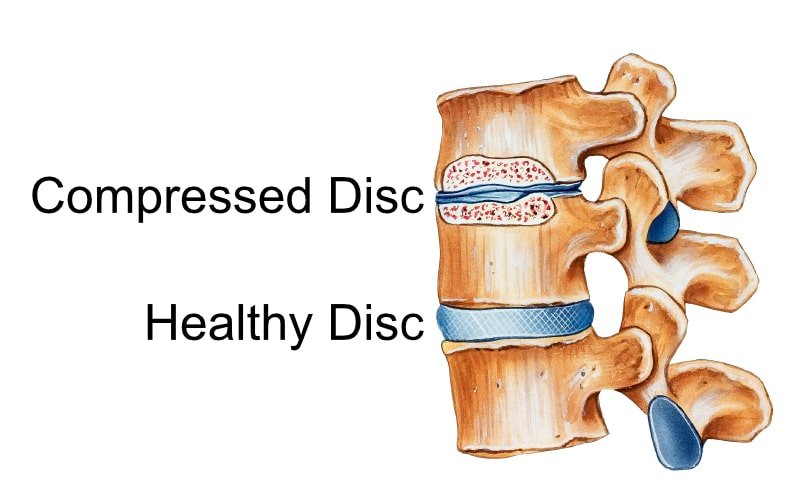
Trabeculae and Shock Absorption
It is important to realize that the trabecular bone inside the vertebral body is a sponge that absorbs the force of impacts when you walk, run, or jump. The trabeculae is strongest when it absorbs the forces evenly.
When you stand in your best postural alignment throughout the day and distribute forces evenly, all of those little trabeculae on the inside absorb the forces evenly. There are thousands of little trabeculae absorbing the forces — and that is a miracle of nature.
Unsafe Loading on the Vertebra
Unsafe loading on the vertebra can occur during a number of activities, including the following:
- Coughing
- Tying your shoes
- Opening the fridge door
- Texting
- Gardening
In each of these instances, there is a constant forward lean on the front of the vertebral bodies. These forces are unevenly distributed across the trabeculae and eventually some of those little trabeculae will crack.

This might not happen the first time you slouch forward. But eventually some will start to crack. And then a few more crack, and then a few more after that.
It’s those thousands of little repeated motions that snaps one of the trabeculae — one of the cross bridges in this internal sponge of the body of the vertebrae.
Another trabeculae snaps and eventually when you go to do something (like reaching for your shoes), that little internal scaffolding can’t hold you up anymore and an outer crack in the cortical bone develops.
Leading to Vertebral Compression
Compression of vertebrae is common over the age of 80 years. With osteoporosis, vertebra can compress at a much younger age. Slight compressions are so common that they are generally not reported until the vertebra is at least 25% compressed.
Sometimes you hear your physician diagnose this as a vertebral compression but not a vertebral fracture. The image below shows a vertebral body (at the top of the spinal column) that is compressed.
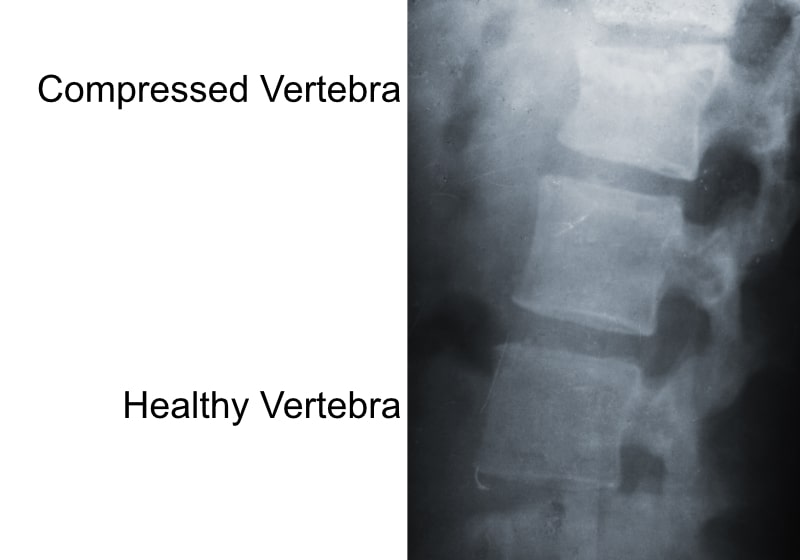
The vertebral body can continue on the path to more compression. The image below shows the same vertebral body eight weeks later. Note how much more the vertebral body is compressed.
Once you know that you have a compressed vertebra, it becomes even more important to be mindful of how you move, push, pull, carry, and do your daily activities. It is well known that once you have one compressed vertebra, that your chance of having another increases.
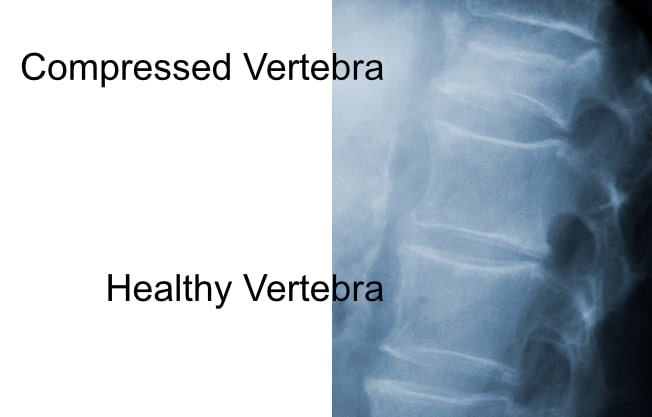
Kyphotic or Osteoporosis Posture
Overtime these vertebral bodies compress to the point where the individual develops a stooped kyphotic or osteoporosis posture.
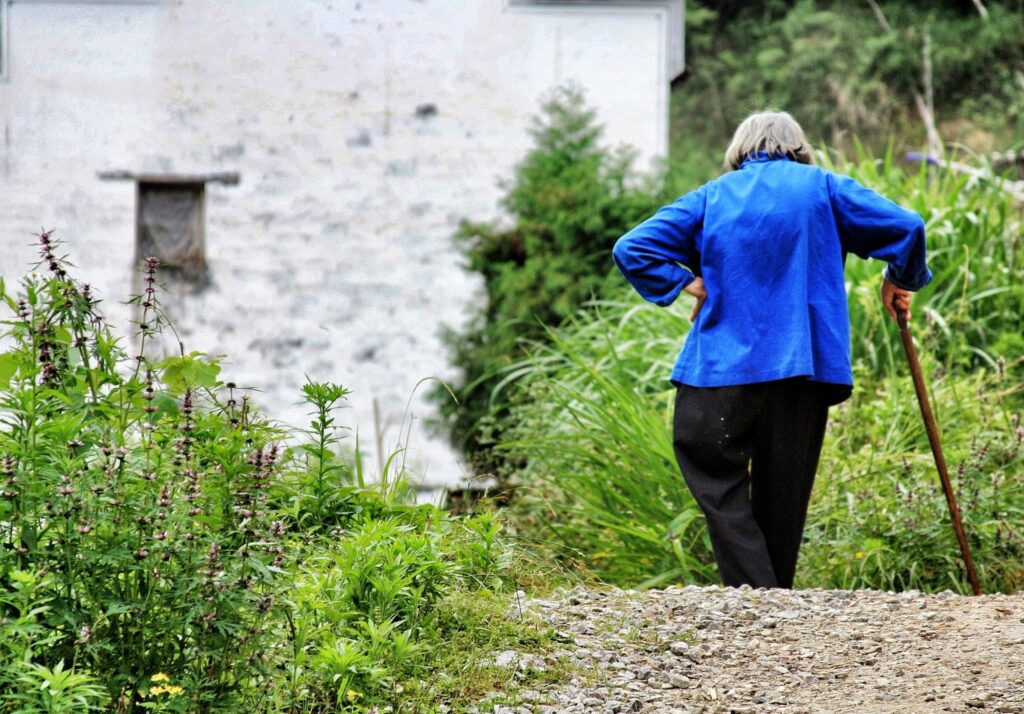
Save Those Forward Flexions
I suggest you reserve those flexions for the precious moments in your life. Otherwise, I recommend you avoid flexion and instead learn to make perfect posture part of your day-to-day life.
Conclusion
Having read this post, you understand the difference between the two types of bone and now have reason to be more careful with your posture.
If you want to learn more about the BMD or DEXA test procedure, read my blog on bone density test. I also prepared an article on understanding bone density test results and, in another blog, explain the FRAX Calculator.
How to Have a Perfect Posture
Posture is the foundation of all movement and exercise. This is why I developed the online course, Perfect Posture in 30 Days.
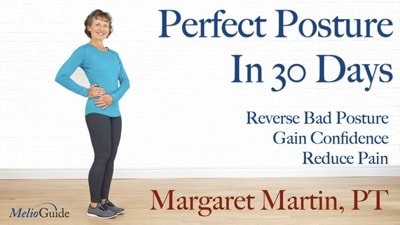
Perfect Posture
A perfect posture has many benefits.
- Reduces your risk of back, neck and shoulder pain.
- Improves balance and the reduces the chance of a fall.
- Promotes a positive self-image.
Posture and Osteoporosis
Good postural alignment is especially important for individuals with osteoporosis and low bone density.
Simple movements you do everyday can lead to small fractures to the spine.
For example, poor postural alignment when you cough, sneeze, or reach for something can cause micro trauma to the spinal column. Over time, these micro traumas can add up and eventually lead to vertebral compression fractures.
A poor posture contributes to balance issues. As a result, individuals with osteoporosis and low bone density are at risk of a macro trauma to the spine because of balance problems.
The Source of Poor Posture
Why don’t more of us have a perfect posture? Because many of the activities we do in today’s modern world involve forward flexion.
Activities such as reading in bed, using a mobile phone, gaming, texting, sitting for hours hunched over a laptop computer, knitting, crocheting, and many more encourage forward flexion.
Many people take this forward movement into their exercise and leisure activities. Unfortunately, this reinforces poor postural alignment.
Unless we make adjustments to our environment or correct our posture, over time we weaken and stretch certain muscles and tighten other muscles. This muscular imbalance leads to poor postural alignment.
We need to fix this imbalance, modify our movements so that we can get the posture we want.
How to Achieve a Perfect Posture
Many of us do not know how to get and keep a perfect posture. To have a good posture we need to learn the fundamentals of good posture, know what exercises promote postural alignment, and how to bring good posture into our day to day activities.
This is why I created Perfect Posture in 30 Days. This course addresses each of these areas and shows you how to develop a perfect posture, how to modify your daily activities, and how to make your perfect posture a permanent part of your life.
Perfect Posture in 30 Days will improve your posture, boost your confidence, and allow you to live a pain free life.
How Many Osteoporosis Posture Exercises?
A patient recently contacted me about her osteoporosis posture exercise program. She was wondering whether she would gain much from an additional osteoporosis posture exercise set.
Here is her question in detail:
Hi Margaret, I remember that you said that the Floor M exercise would be especially valuable to me. Since then, I have done one to two sets of Floor M every other day.
It’s sometimes hard to do two sets; but one set is doable.
How much more benefit do you get from doing two sets versus one set? (I am using a three pound sand weight on my upper back/shoulder area when I do the exercise.)
I must say I have reached the point where I feel the difference in my body because I can stand up straighter and my husband has noticed! Feel better! LOVE your program! Thanks again.
Osteoporosis Posture Exercise • The Answer
I was excited to hear about her dedication and her progress. Here is my response:
Thank you for sharing the good news about your posture changes. Very exciting!!
Studies have shown up to a 40% increase in strength when going from one set to two sets on an exercise. So it is worth it! Consider using one to two pound weights on your back for the second set until things get easier.

The Lesson Learned
This demonstrates that a small change in someone’s exercise program can have dramatic effects.
In this case, increasing the number of sets by one could lead to a 40% strength gain. And if the leap was initially too much, the client could gradually build up her sets by incrementing (or decreasing) her weight so that she could progress.
Postural Dysfunction and Low Back Pain
Could your quest for the perfect posture causing you low back pain? I have client who is a perfectionist. I have coached her to be more careful about her postural alignment. She follows everything I say — to the letter.
I have encouraged her to flex from the hip and avoid flexion of the spine. As a result, she has completely eliminated spinal flexion in her exercise movements and activities of daily living! However, this has lead to a condition called flexion dysfunction which, in turn, has caused her to experience low back pain.
Flexion Dysfunction
If you are a Physical Therapist, look out for this condition when assessing your clients. If you are a client, you probably should seek guidance from an experienced Physical Therapist.
I encourage her to maintain a full range of motion in her spine.
Flexion Dysfunction Exercises
At the same time, I am not telling her to practice poor posture and flex from the spine in an unsafe way.
However, I do urge her to do some flexion in unweighted positions. These could be performed in the water or lying on your side — where you allow your spine to get into its full range of flexion and extension.
The video illustrates these recommended flexion dysfunction exercises.
References
- Huang MH, et al. Hyperkyphotic Posture and Risk of Future Osteoporotic Fractures: The Rancho Bernardo Study. Journal of Bone and Mineral Research (JBMR). Published online 2005 Dec 5. 2006 March; 21(3): 419-423
Perfect Posture and Postural Alignment
I have a page dedicated to Perfect Posture.

Comments
January 7, 2015 at 7:29pm
Marianne Gubler
You are a such a good teacher! I appreciate your constant reminders and insights into bone care. Thank you.
May 25, 2016 at 7:27pm
Terri
Thank you for such valuable and available information. Some of us (me) have forgotten what we learned years ago. You explain the information in simple terms.
Thank you for your dedication.
Sincerely,
Terri
January 16, 2018 at 1:13pm
Liz Horton
I am a Yoga teacher with advanced studies in anatomy and therapeutic applications of Yoga. I am so glad I found your site. You are an excellent teacher and your knowledge and expertise is at one of the highest levels I’ve come across (and I study a lot of material from many respected, educated teachers and licensed medical professionals).
I share your videos and blogs with my students and I have bone density issues myself, so I watch your videos daily now as part of my own practice. I also purchased your book and look forward to adding it to my library.
Thank you for all you do to educate and keep us safe and healthy!
Warm Namaste,
Liz
January 17, 2018 at 9:31pm
Margaret Martin replies
Thank you for your kind words Liz. I wish more Yoga instructors were as knowledgeable as you. Your students are lucky to have you.
Thank you for supporting my work through the purchase of my book and sharing my material. All the best.
Margaret
October 23, 2019 at 7:07pm
rima
Hi, Margaret, Is there someplace on your site where you show how to tie shoes (and put on and take off shoes and socks) and get things in and out of the refrigerator, dishwasher, and washer and dryer? Seriously -- these are things I do every day and I need to know how to do them safely! Thank you
October 29, 2019 at 8:36pm
Margaret Martin replies
Hi Rima,
Thank you for asking. Yes, the daily activity guide: http://melioguide.com/health-guides/activities-of-daily-living/
does have a few of the items you mention. The other 40 or so examples of safe daily activities are accessible through a link that is provided in my book, Exercise for Better Bones. My book revenues help us to keep producing everything we feel is important to keep individuals like yourself safe and strong.
If you are not able to afford the cost of the book please send us a message through the contact us link on our web site: http://melioguide.com/contact/ let us know that you would like the information but that the cost is prohibitive for you and we will provide you with the link free of charge.
Wishing you all the best!
Margaret
August 27, 2020 at 2:59pm
Carmen
I am 72 years old, I have osteoporosis and I already have 6 compression fractures in my spine. My posture is slumped. I need safe exercises to strengthen my muscles without doing further damage to my spine. I also broke one of my legs several years ago (unrelated to my spine). The injury also severely damaged my knee so I do not have normal flexibility in that knee. I'm a mess, any suggestions?
August 27, 2020 at 3:12pm
Richard Martin replies
Hi Carmen. Thanks for contacting us. Sorry to hear about your health situation. We suggest you work with your physician and a physical therapist to address these issues.